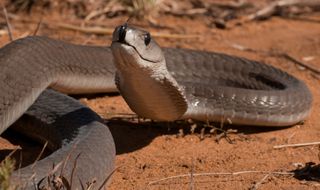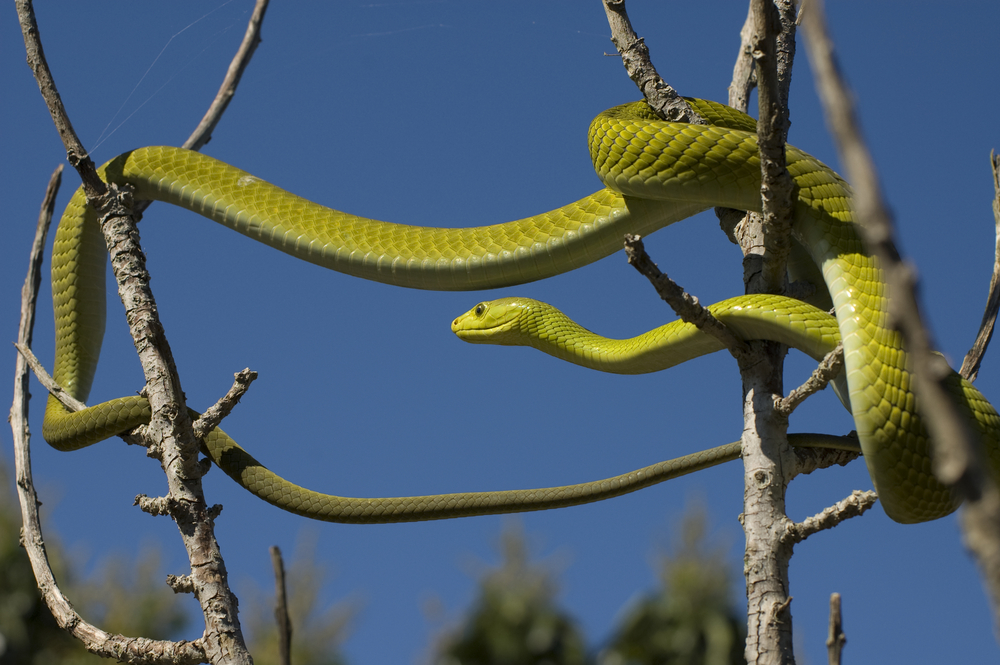What Animal Can Survive A Mamba Bite
Black Mamba Facts

The black mamba has quite a reputation. It is one of the globe'due south deadliest snakes. It is the fastest land snake in the world, and "the longest species of venomous serpent in Africa and the 2nd longest in the world," said Sara Viernum, a herpetologist based in Madison, Wisconsin. This snake's potential danger has been the subject of many African myths and it has been blamed for thousands of human deaths.
The black mamba's reputation is not undeserved. "Black mambas are extremely toxic and very fast snakes," Viernum said. They are highly aggressive when threatened, "known to strike repeatedly and [to] inject a large book of venom with each strike." Their venom is potentially lethal, and though antivenin exists, information technology is not widely available in the black mamba's native habitat of southern and eastern Africa. For this reason, they are considered a peak killer in a state where nearly xx,000 people die from snake bites every year, co-ordinate to PBS's Nature.
Characteristics
Contrary to what its name would suggest, black mambas are actually brownish in color, ranging from olive to greyish tones, with paler bellies. "They are named for the coloration of the inside of their mouths, which is a deep, inky blackness," explained Viernum. "Like to cottonmouths, when threatened a mamba will open its mouth to show the black lining as a warning signal."
Black mambas have coffin-shaped heads and are lithe, athletic snakes. Co-ordinate to National Geographic, they can abound to be fourteen anxiety long (4.25 meters), though their average length is around eight feet (2.4 m). These giants tin live upwardly to 11 years in the wild.

Habitat
Black mambas reside in South and East Africa's savannas, rocky hills and open woodlands, according to the University of Michigan Museum of Zoology's Animal Diverseness Web (ADW). They like low, open spaces and savor sleeping in hollow trees, rock crevices, burrows, or empty termite mounds.
Habits
These speedy serpents can move faster than most people can run, a fact that partly explains why they are so feared. Viernum said, "Black mambas are one of the fastest species of snakes, reaching slithering speed up to 12 mph [nineteen kph]." This is undoubtedly fast, but still slower than the myths of them outrunning horses would suggest. Over longer distances, they average about 7 mph (xi kph).
They slither quickly in short bursts over level ground, and can zoom along with about one-third of their bodies off the footing and their heads proudly held high. The blackness mamba racing along with its head nearly 4 feet (1.2 1000) in the air is a terrifying and amazing sight. However, co-ordinate to National Geographic, black mambas use their incredible speed to escape threats, non to hunt.
Blackness mambas hunt and are agile during the day and return to the same identify every dark to sleep. According to Widescreen'southward ARKive Initiative, they are frequently seen "basking in the branches of a tree in the early on morning" earlier going hunting. Black mambas are sometimes found in pairs or minor groups, though Viernum emphasized their fundamental shyness. She said that they are "shy and secretive snakes that adopt to escape confrontation." However, "black mambas can go highly ambitious if threatened. Their defensive behavior is their near distinctive behavioral characteristic.
"When threatened with no perceived available escape, these snakes will enhance their upper body off the ground to stand erect," Viernum said. Their front third of their bodies tin can ascension iii to 4 anxiety (0.9 to 1.two 1000) off the ground. Then, they volition "spread their cobra-similar neck flaps [and] gape their mouths to expose the black lining." This is a defensive posture aiming to scare away the threat. If black mambas demand to assail to defend themselves, they will "strike repeatedly, potentially evangelize large doses of venom with each strike, and hiss loudly." Then, they'll slither away as fast every bit possible.
Blackness mambas have no specific predators. Their greatest threat is habitat devastation, according to the ARKive.

Nutrition
Black mambas typically eat modest mammals and birds, though according to Blue Planet Biomes, there have been reports of mambas found with whole parrots or total-grown cobras in their stomachs. In his volume Black Mambas (Checkerboard, 2006), Adam Grand. Klein wrote that blackness mambas hunt by biting their prey and injecting venom, then releasing it. They then follow it until it becomes paralyzed or dies, at which signal they swallow it. It doesn't usually have casualty very long to die later on beingness bitten by a black mamba. Black mambas devour their food whole. They have flexible jaws that they can dislocate in order to fit food up to iv times the size of their head into their mouth.
Reproduction
According to the University of Wisconsin-La Crosse'due south BioWeb, black mambas usually mate during the jump or summer. Males fight for the affections of females. Later mating, females lay betwixt half-dozen to 25 eggs in a clammy, warm burrow. The female leaves her eggs and never sees them once more. Babies hatch about three months later on and are born measuring between 16 and 24 inches.
Bite
But two drops of stiff black mamba venom tin can kill a human, according to South Africa's Kruger National Park. "Like cobras and coral snakes, the venom of a black mamba contains neurotoxins," Viernum told Live Science. She described the venom equally "fast-interim." It shuts down the nervous system and paralyzes victims, and without antivenom, the fatality charge per unit from a blackness mamba bite is 100 percent. "Fatalities from black mamba bites have been documented to occur inside every bit little equally 20 minutes afterward injection," said Viernum. "However, most known fatalities have occurred within 30 minutes to three hours or longer."
Taxonomy/nomenclature
The black mamba is one of 4 species of mambas, according to the Integrated Taxonomic Information System (ITIS). Others are Jameson's mamba, eastern green mamba and western green mamba. Mambas are in the same family, Elapidae, as coral snakes and cobras. Mambas are slender, active and active, with shine scales and powerful venom. They all alive throughout sub-Saharan Africa.
Co-ordinate to ITIS, the taxonomy of mambas is:
- Kingdom: Animalia
- Subkingdom: Bilateria
- Infrakingdom: Deuterostomia
- Phylum: Chordata
- Subphylum: Vertebrata
- Infraphylum: Gnathostomata
- Superclass: Tetrapoda
- Class: Reptilia
- Order: Squamata
- Suborder: Serpentes
- Infraorder: Alethinophidia
- Family unit: Elapidae
- Genus:Dendroaspis
- Species:Dendroaspis angusticeps(Eastern green mamba),Dendroaspis jamesoni(Jameson's mamba),Dendroaspis polylepis(black mamba),Dendroaspis viridis(West African dark-green mamba)
Other mambas
The other mamba species are all smaller and slightly less venomous than the black mamba, though notwithstanding very poisonous. These snakes are all brilliant green. They are besides all arboreal species, residing in trees. They are known to driblet from branches onto their prey below. All are lone snakes.
Jameson'south mamba
This is a slender serpent that lives in trees and actively and chop-chop pursues its pocket-sized creature casualty during the 24-hour interval, according to the Cincinnati Zoo. It can grow upwards to 8 feet long (2.four 1000) and lives in West and Central Africa.
Eastern green mamba
This is the smallest mamba, commonly measuring about half-dozen or 7 feet (1.8 to 2.1 m), according to Reptiles Mag. It is common in the forests throughout East Africa.
West African green mamba
Also known as the Western green Mamba or Hallowell's green mamba, this snake can accomplish 10 anxiety (three m), according to Branson's Wild World. It is the second-longest venomous snake in Africa, after the blackness mamba. Every bit its name suggests, information technology lives in West Africa.
Additional resources
- BioWeb: Dendroaspis polylepis
- ARKive: Blackness mamba
- ADW:Dendroaspis polylepsis
Source: https://www.livescience.com/43559-black-mamba.html
Posted by: vaughtthastenthe.blogspot.com

0 Response to "What Animal Can Survive A Mamba Bite"
Post a Comment